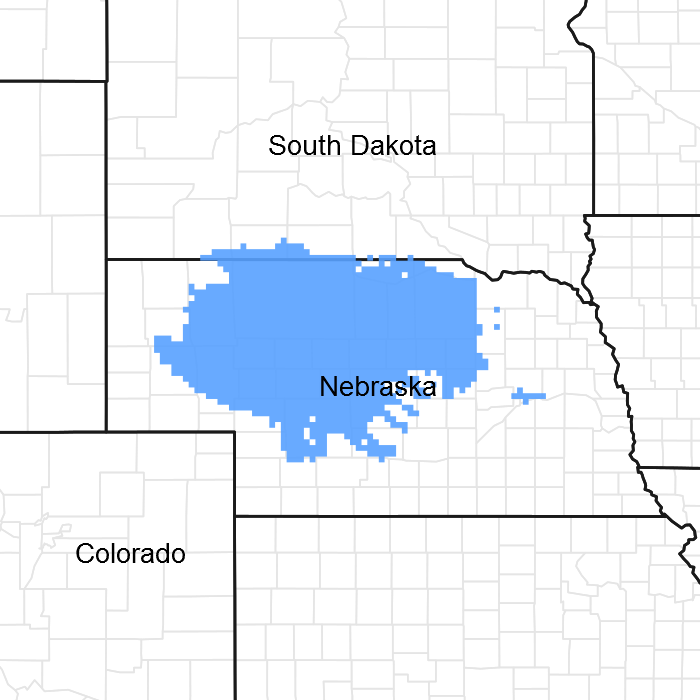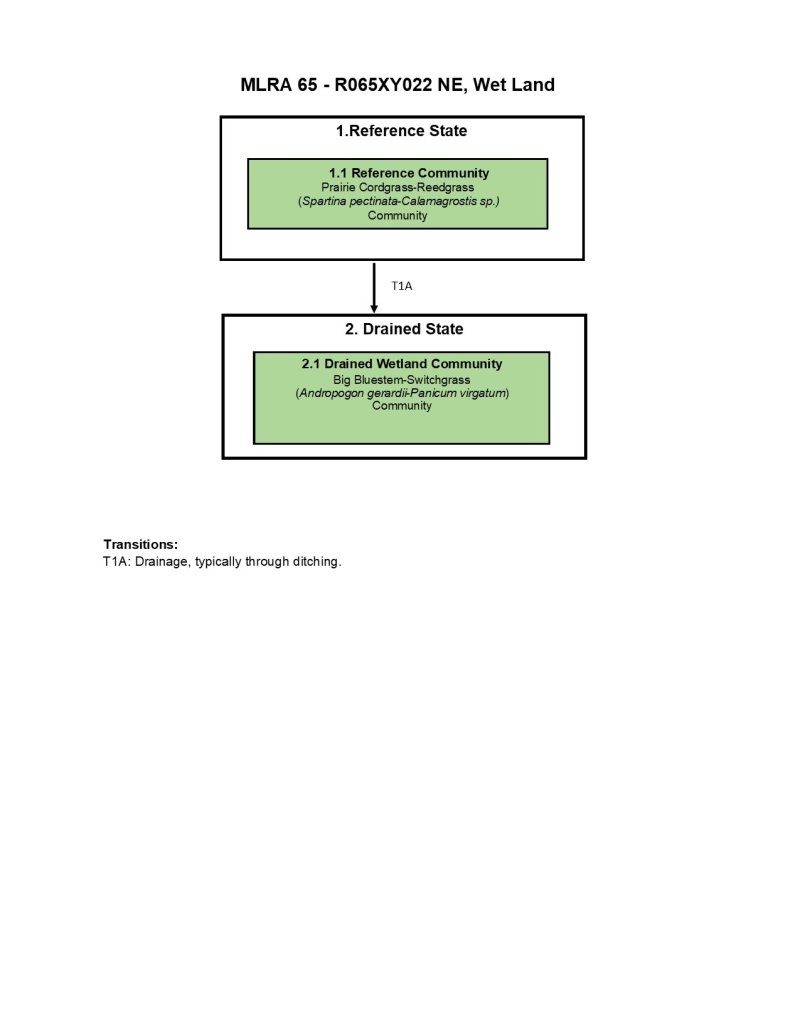
Natural Resources
Conservation Service
Ecological site R065XY022NE
Wet Land
Last updated: 2/04/2025
Accessed: 12/21/2025
General information
Provisional. A provisional ecological site description has undergone quality control and quality assurance review. It contains a working state and transition model and enough information to identify the ecological site.

Figure 1. Mapped extent
Areas shown in blue indicate the maximum mapped extent of this ecological site. Other ecological sites likely occur within the highlighted areas. It is also possible for this ecological site to occur outside of highlighted areas if detailed soil survey has not been completed or recently updated.
MLRA notes
Major Land Resource Area (MLRA): 065X–Nebraska Sand Hills
The Nebraska Sand Hills (MLRA 65) is located in Nebraska (98 percent) and South Dakota (2 percent) and encompasses approximately 13.2 million acres (534,201 hectares) or 20,625 square miles (53,420 square kilometers). The largest town in the MLRA is North Platte, Nebraska and numerous small towns and villages are located within the MLRA, including the county seats of Arthur, Bartlett, Bassett, Brewster, Greeley, Hyannis, Mullen, Thedford, and Tryon, Nebraska. The Niobrara River is near the northern boundary while the North Platte River flows along the southwest boundary of the area. The North Loup, Middle Loup, Calamus, Snake, and Dismal Rivers and Long Pine Creek occur in the central and eastern portion of the area.
Fort Niobrara, Crescent Lake, and Valentine National Wildlife Refuges and portions of the Nebraska National Forest, including the Bessey Ranger District and Samuel R. McKelvie National Forest, are located within this MLRA. The Bessey Ranger District includes the largest human-planted forest in the United States and is home to the Bessey Tree Nursery which is listed on the National Register of Historic Places.
This MLRA is defined by an 8,000 year-old landscape of sand hills dominated by rolling to steep sand dunes with narrow, elongated, nearly level to steeply sloping valleys between the dunes. Dune heights range from 10 to 400 feet (3 to 130 meters) and slopes may exceed twenty-five percent. Dune complexes often extend for several miles in a northwest to southeast direction. These Quaternary sand dunes are derived from the underlying Tertiary Ogallala and Arikaree Groups, which formed when rivers deposited sediments from erosional detritus after the uplift of the Rocky Mountains to the west. The Nebraska Sand Hills are the largest sand dune area in the Western Hemisphere and one of the largest grass-stabilized dune regions in the world. The soils of the MLRA are principally derived from deep eolian sand.
The Ogallala aquifer underlies the MLRA and is the most extensive and heavily used aquifer of the high plains between the Rocky Mountains and Mississippi River. The aquifer is at its thickest in the Sand Hills which are a primary recharge are for the aquifer. Numerous small permanent and intermittent lakes and wetlands occur in the MLRA. While the dominant source of water for these lakes is precipitation, groundwater discharge is important to maintaining these lakes especially in drier years. A number of these lakes, especially in the western portion of the MLRA are alkaline.
Considered to be a western extension of the tallgrass prairie, the matrix vegetation is a unique mix of species that is sometimes identified as Sandhills Prairie. Sand bluestem, prairie sandreed, Indiangrass, switchgrass, sand lovegrass, little bluestem, and needle and thread are the primary grasses. Porcupinegrass is a significant cool-season grass in the eastern portion of the MLRA while blue grama and hairy grama are important warm-season grasses in the western portion due to differences in precipitation. Soils which have a high water table support a tallgrass prairie dominated by big bluestem, switchgrass, Indiangrass, prairie cordgrass, and a variety of grass-likes. The endangered plant blowout penstemon (Penstemon haydenii) is found in this MLRA.
More than ninety percent of the land in MLRA 65 is native grassland utilized by grazing livestock. Areas along streams and in subirrigated valleys are utilized for prairie hay. Wetlands, legume hay, and irrigated cropland make up the balance of the land area with corn being the principal irrigated crop.
Wildlife flourishes in this native grassland environment. Historically large bison herds occupied the landscape. White-tailed deer, mule deer, pronghorn, black tailed jackrabbit, and coyote are now the major mammalian species. Upland sandpiper, lark bunting, grasshopper sparrow, western meadowlark, long-billed curlew, sharp-tailed grouse, and greater prairie chicken are common avian species. The mosaic of grassland and wetlands provide excellent habitat for wading and shorebird species as well.
This landscape serves as a backdrop for a disturbance-driven ecosystem, which developed under the influences of herbivory, fire, and periodic long-term drought. Historically, these processes created a heterogeneous mosaic of plant communities and vegetative structure across the region. Any given site in this landscape experienced fire every six to ten years. Fires were caused by lightning strikes and also were set by Native Americans, who used fire for warfare, signaling, and to refresh the native grasses. Indigenous peoples understood the value of fire as a tool and that the highly palatable growth following a fire provided excellent forage for their horses and attracted grazing animals such as bison, elk, and pronghorn.
The natural fire regime has been disrupted by aggressive fire suppression policies which have facilitated woody species encroachment by both native and introduced shrubs and trees into the native prairie. The most common encroacher is eastern redcedar. While eastern redcedar is native to the landscape, it was present only in trace amounts due to the periodic fires. Widespread plantings of windbreaks with eastern redcedar as a primary component have provided a seed source for this aggressive woody plant causing encroachment into native grasslands, especially in the eastern and central Sand Hills. This encroachment causes significant forage loss for domestic livestock and degrades the native wildlife habit. Since it is not a root-sprouter, eastern redcedar is very susceptible to fire when under six feet tall making management with prescribed fire very effective when applied before trees reach this stage.
Classification relationships
►USDA-NRCS (2022)◄
Land Resource Region – G, Central Feed Grains and Livestock Region
Major Land Resource Area (MLRA) –65, Nebraska Sand Hills
►Fenneman (1916) Physiographic Regions ◄
Division – Interior Plains
Province – Great Plains
Section – High Plains
►USDA-USFS (2007) Ecoregions◄
Domain – Dry
Division – Temperate Steppe
Province – Great Plains Steppe (332)
Section – Mixed Grass Steppe
►EPA Ecoregions (Omernik 1997)◄
I – Great Plains (9)
II – West-Central Semi-Arid Prairies (9.3)
III – Nebraska Sandhills (44)
IV – Sandhills (44a), Alkaline Lakes Area (44b), Wet Meadow and Marsh Plain (44c), Lakes Area (44d)
Ecological site concept
The Wet Land ecological site is a run-on site found primarily on interdunes and on stream valleys with slopes of 1 percent or less. The site is generally saturated or ponded for a long duration at or near the surface during the growing season to a depth of up to 6 inches.
The historic vegetation of the Wet Land ecological site is tallgrass prairie. Vegetation in the Reference Community (1.1) is a mixture of cool-season grasses and warm-season tallgrasses. Dominant grasses include prairie cordgrass, bluejoint, northern reedgrass, and stiffstem reedgrass. The plant community includes a diversity population of forbs. Typical shrubs include dwarf false indigo and willows.
Associated sites
| R065XY023NE |
Wet Subirrigated The Wet Subirrigated ecological site is typically found interspersed with Wet Land ecological sites in interdunes and stream valleys. |
|---|---|
| R065XY024NE |
Subirrigated The Subirrigated ecological site is typically found interspersed with Wet Land ecological sites in interdunes and stream valleys, but Subirrigated sites are found on a slightly higher landscape position. |
Similar sites
| R065XY026NE |
Deep Wetland Wet Land and Deep Wetland ecological sites are very similar. The primary difference between the two sites is the length and depth of ponding. Ponding is deeper (up to 24 inches) and of very long duration on Deep Wetland sites. |
|---|
Table 1. Dominant plant species
| Tree |
Not specified |
|---|---|
| Shrub |
Not specified |
| Herbaceous |
(1) Spartina pectinata |
Click on box and path labels to scroll to the respective text.
Ecosystem states
| T1A | - | Drainage, typically through ditching. |
|---|
